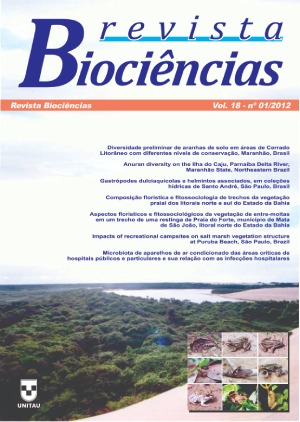Impacts of recreational campsites on salt marsh vegetation structure at Puruba Beach, São Paulo, Brazil
Resumen
Campsites can impact the vegetation structure by changing the forest composition and causing a loss of vegetation cover and organic matter. The aim of this study was to analyze the impacts of campsites over the vegetation structure of the salt marsh (restinga) in Puruba beach, Ubatuba, São Paulo, Brazil. For this, we estimated canopy cover, herbaceous cover, tree basal area, tree density, Bromelia antiacantha Bertol abundance and litter thickness in 20 old campsite areas and 20 control quadrants. We estimated that 26% of the salt marsh area was affected by camping activities. The vegetation structure varied across areas with and without recreation activities. The result shows higher mean values in areas without camping for canopy cover, herbaceous cover, B. antiacantha abundance and litter thickness. We found no differences in tree basal área and tree density. This finding can be attributed to the fact that campers are not cutting large trees to make their campsites because they are likely to prefer using areas that have already been opened. This type of behavior makes the herbaceous stratum to be more affected by user intensity and frequency than tree stratum. We did not find a significant relationship between vegetation structure and clearing size of campsites. This result indicates that the recovery rate is slow regardless of the size of impacted área making salt marches areas fragile environments for recreational campsites and some life forms are more negatively affected than others. An alternative to carry on this kind of outdoor activity in Puruba Beach is to implement facilities for users to camp in open areas with easy access to the beach.Descargas
Los datos de descargas todavía no están disponibles.
Métricas
Cargando métricas ...
Descargas
Publicado
2012-11-14
Cómo citar
Scabin, A. B., & Voltolini, J. C. (2012). Impacts of recreational campsites on salt marsh vegetation structure at Puruba Beach, São Paulo, Brazil. Revista Biociencias, 18(1). Recuperado a partir de https://periodicos.unitau.br/biociencias/article/view/1533
Número
Sección
Ciências da Natureza






